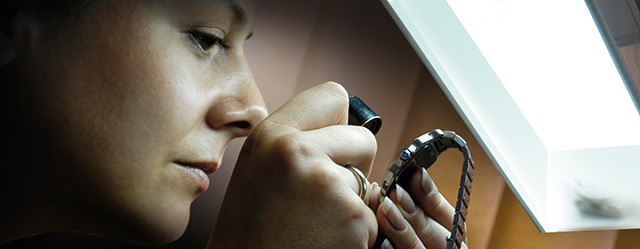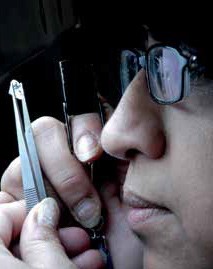Meet the Experts valuations
Valuations
In this month’s instalment of the Assay Office Birmingham series looking at the challenges faced by its experts, SafeGuard Jewellery Valuations explains how they apply their knowledge on a daily basis.

Armed with a 10x loupe, some basic gemmological equipment and decades of experience, SafeGuard’s valuers can identify and value the majority of pieces they see in a relatively straightforward way.
Those customers who have inherited jewellery or made an impulse ‘bargain’ buy for a bit of fun, may genuinely have no idea of the real worth of their jewellery, but will usually secretly hope that its material value is as high as its sentimental value. When presenting their goods for valuation, many people are poised for an Antiques Roadshow type experience, with the item being given a value way beyond their expectations.
Rising gold and diamond prices have created many such moments for those with items bought from legitimate sources, and customers have gone away very well satisfied with their valuation and their treasured possession. However, rising prices and the current economic climate have also spawned unpleasant new practices.
In the past 12 months particularly, SafeGuard has received regular complaints relating to vulnerable people who have been duped into buying ‘investment’ diamonds or coloured gemstones at vastly inflated prices. While there are legitimate companies offering genuine investments, there are also those who have identified an opportunity to exploit un-informed members of the public. SafeGuard neither buys, sells nor has any connection with insurance replacement, and so its impartiality and total independence from the trade make it an obvious choice for those seeking an independent expert opinion. Such work requires all of a Valuers' extensive knowledge and expertise.
In order to arrive at a realistic average selling price, one first has to assess the quality of the diamond to ensure that it is what it purports to be. In the case of a coloured diamond or gemstone this may also require input from the gemmological experts in the AnchorCert Gemmological Laboratory (another division of the Assay Office) who will use their battery of state-of-the-art equipment to assess the stone and identify whether it is natural, synthetic or treated.
Having properly identified the stone, desktop research through Rapnet and the NAG guidelines give our experts a general guide as to its price. In order for his evidence to stand up in court, if the case gets that far, they then need to validate the theoretical prices by testing them against quotes for a similar stone from a range of stone dealers. Our expert says: “This is very time consuming research. It is not unusual for the original price paid to be three or four times the high street replacement value, and we need to be sure we can prove the excessive price inflation with proper evidence.
“Part of the skill of being a valuer is to understand and allow for the wide range of mark-ups used by the jewellery trade, but for these sorts of loose stones it is the biggest minefield of all. The victims of these scams tend to be vulnerable people who are duped into ‘investing’ by continual sales pressure, usually by telephone. SafeGuard is committed to ensuring we provide the best possible evidence to stop this.”
The valuers are also responsible for ensuring valuations and standards remain consistent throughout the SafeGuard team, and for arbitrating where items are not clear cut or are particularly unusual. The categories most likely to need a second opinion or a consultation between all of the valuers are high-end watches and coloured gemstones.
As with every other task at Assay Office Birmingham, the most important starting point is a straightforward visual assessment by an experienced expert using a 10x loupe. If necessary the valuer will then move to a microscope and, in the case of gemstones that do not ‘feel right’ to the SafeGuard valuers, there are all of the resources of AnchorCert available to use in order to reach a proper decision.
 An experienced valuer can usually spot a counterfeit watch fairly readily, as there are small tell tale details immediately obvious to the experienced eye. However, SafeGuard is seeing an increasing number of ‘hybrids’, which are made up from genuine components but do not constitute a recognised model. There is also a growth in the number of watches that have been ‘enhanced’ by the addition of, for example, diamonds set into the bezel. This may apparently increase the material value, but in fact the original watch house will now disown the piece, which may mean it will no longer be accepted for service or be recognised by the brand, devaluing it significantly. The watch house may choose to remove customised parts and replace with original parts, charging the customer accordingly, before it carries out any other work on an adapted watch.
An experienced valuer can usually spot a counterfeit watch fairly readily, as there are small tell tale details immediately obvious to the experienced eye. However, SafeGuard is seeing an increasing number of ‘hybrids’, which are made up from genuine components but do not constitute a recognised model. There is also a growth in the number of watches that have been ‘enhanced’ by the addition of, for example, diamonds set into the bezel. This may apparently increase the material value, but in fact the original watch house will now disown the piece, which may mean it will no longer be accepted for service or be recognised by the brand, devaluing it significantly. The watch house may choose to remove customised parts and replace with original parts, charging the customer accordingly, before it carries out any other work on an adapted watch.
The obvious alterations will be picked up immediately by an expert valuer, but sometimes it is a gut instinct that suggests something is not right, and the Valuer is often called upon to share his expertise with other members of the SafeGuard team. Registration numbers are checked, tiny details scrutinised and discussed, and if the team are still unsure the watch may be sent to an authorised watch expert who can remove the back of the case and allow the valuers to inspect the movement and so make a clear-cut decision. Experience is everything.
Your item has been added to the basket
You need to create an account, or login before you can add this item to your basket.

